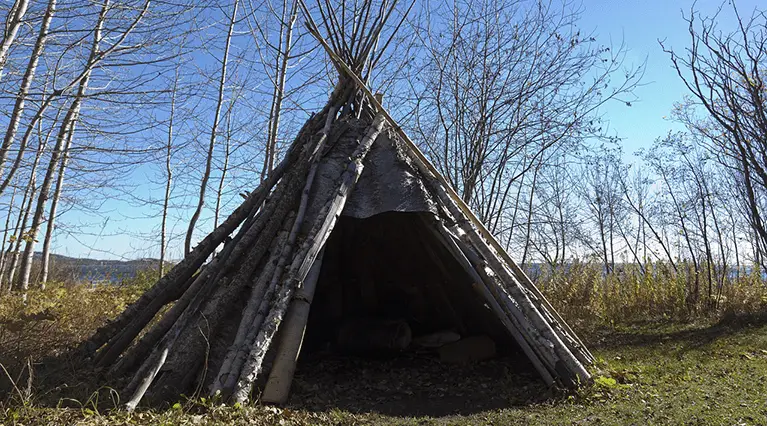Last modified on December 8th, 2021 at 11:01 am
How to Build Your Own Outdoor Shelter
In this modern-day and age, knowing how to build an outdoor shelter might seem like an unnecessary skill. But life can throw some unexpected things at you, and knowing how to build an outdoor shelter could be a game-changer when you least expect it.
Building an outdoor shelter is relatively easy once you know how, and it is a skill that will last your lifetime once you have it. It is the type of survival skill that is good to pass along to others among your family and friends.
This post will teach you how to build a basic, one-person outdoor shelter with materials that are available in nature, along with a couple of household items.
Things You will Need To Build Your Own Outdoor Shelter
- Survival knife
- Tree limbs
- Cordage
- Leaves or tarp
- Shovel
- Optional (bucket)
Step 1: Find a suitable location
You will want to look for a site that is both flat and dry. Starting on a damp building site will compound difficulties in building and will adversely impact your comfort once you are done. If you build your shelter on a slope and it starts to rain, your shelter could get washed away or flooded.
While you might be tempted to set up camp next to a water source, keep your distance. Lakes or rivers can overflow their banks, and animals will also be looking for a water source, so keep the water in sight, but don’t build on the shores.
Ensure that you are not in a location where overhead dead tree branches, rock slides, or nearby ravines could pose a danger. It is also best to have an area close to your doorway where you can start a fire for cooking and warmth.
Step 2: Mark the Location Of The Building Area
The type and location of the outdoor shelter that will be best will depend on your needs. Is it just you? Or are there several people who will need shelter?
What is the weather like; is it cold, rainy, or do you need sun protection? Will you need to build a fire inside the shelter or directly in front? The answer to these questions will help you to determine the best outdoor shelter to construct. For this article, we describe a basic, get out of the elements, type of shelter for one person.
Use your shovel to smooth out the ground so that it is flat. Clear the area of debris, and remember the story of The Princess and the Pea. You are going to feel any and all small stones that you don’t remove. If you have not brought a shovel, use tree branches with leaves to “sweep” over the area and smooth it out.
Step 3: Prepare Tree Limbs, Tree Trunks, and Sticks
Determine the length and width that you will need the shelter to be so that you will be comfortable while inside. Making the shelter too short so that you cannot stretch out will make your time in the shelter miserable.
Using a survival knife, prepare tree branches about three inches in diameter, sturdy, and relatively straight. Make sure that you have a survival knife that is up to the task. The knife should have a fixed carbon steel or stainless steel blade with a solid handle. A knife with a blade that is four to nine inches long is the best for preparing tree branches and limbs.
Start by getting several tree limbs; you can add more later if you don’t have enough. You are also going to need to find one long, sturdy branch. This branch should be a few feet longer than you are tall. This is the branch that will support the smaller branches of the shelter.
Step 4: Find Framing for Your Shelter
You will want to find a relatively flat area, as described in Step 2, that has a tree, stump, rock, or log that you will be able to prop one end of your sturdy branch upon. You could also choose to support the ends of the branch on two shorter branches, making an A shape frame. This setup will act as the base of your shelter.
A two-forked tree is also an excellent alternative to use. You will want to have this tall enough that you will be able to sit up inside once the shelter is done, but not so high that the shelter is difficult to construct and will not retain your body heat if you are facing cold weather.
Step 5: Start Building Your Shelter
Prop the one long, sturdy branch against the tree, rock stump, or log that you have found suitable for the task. Once that branch is in place, start to prop the shorter branches against the main branch on each side, making the A shape.
This arrangement will give you the frame of your shelter. Try to place the branches as close to one another as possible to minimize gaps that allow the elements in.
With the cordage that you brought along, tie up the side branches to the main branch. This will keep them in place so that they are not falling as you enter and exit the shelter and secure them from the wind.
Step 6: Make Shelter Windproof and Waterproof
If you might experience rainy weather, it is a good idea to make your outdoor shelter as waterproof as possible. The same preparations will help keep out the wind too.
A small tarp is the handiest and easiest way to cover the shelter that you have made out of the branches and tree limbs. Drape the tarp over the shelter and use the cordage you brought to secure it to the branches.
Look for tree branches in the area that still have the leaves on them. Pine branches are also a good option. Covering the trap with these resources will help keep it in place and protect it from the wind. If you have leaves off the branches, you can use them, along with mud, to layer on the tarp and keep it in place.
Step 7: Create a Fire Pit
A fire pit will help to keep you warm if it is cold and will provide light and the ability to cook your food.
Select a flat spot that is close to your shelter but not so close that it will be a danger of catching the shelter on fire. Note the direction that any prevailing winds are coming from, and keep the fire pit protected from the winds to keep the coals from being blown out.
Build the pit on top of gravel, sand, or bare soil. Stay clear of overhanging branches or debris on the ground that would be flammable. Have at least ten feet around the fire pit that is clear and open. Make sure to keep a bucket of water or a pile of dirt close by if you need to put the fire out.

Final Thoughts
Survival skills are important because you never know when you might find yourself in a real-life survival situation. Life has a way of surprising us!
Never underestimate the importance of knowing how to take care of yourself no matter the situation. Learning survival skills also teaches you how to think and react under pressure.
Building your outdoor shelter will be an essential first step in gaining skills that will help you to take care of yourself no matter what comes your way.
I have been a nature enthusiast since I was a small girl. My background is in online marketing and website development. It only makes sense to merge my love for nature with my skills in online marketing to help spread awareness, and appreciation for Our Beautiful Planet.




